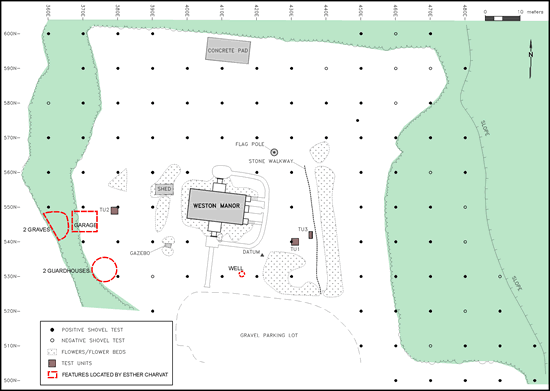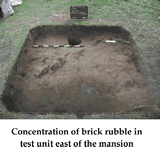July 31, 2003
The 2003 season's work began with systematic shovel testing of the HHF property. A total of 104 individual tests were located at 10 m (33 ft) intervals over the entire tract. All fill was screened to recover artifacts and representative soil profiles were recorded on standard forms. Large numbers of prehistoric Indian artifacts (mainly flaked stone) were recovered in addition to items associated with occupation of Weston Manor itself. The latter material dates mainly from the 19th century although occasional pieces of late 18th century ceramics appear as well. Interesting items from the historic period are an 1848 coin and a Civil War bullet. Laboratory analysis of the artifacts is still underway.
 Map: To collect an even archaeological sample, a grid of shovel tests (small
dark or open circles) was excavated across the entire site, including
the wooded areas (shaded green) at the edge of the lawn. Easting and
northing grid coordinates are shown along the top and left edges of the
map. With the information gathered from the shovel testing phase, three
locations were chosen for excavating larger, square test units (shaded
brown). These were chosen based on concentrations of artifacts that
indicated the presence of former structures. The map also shows the
approximate locations of yard features and two graves that Esther
Charvat remembered from her childhood visits to the property in the
1920s. Ms. Charvat and her husband lived at Weston from the 1950s until
the Historic Hopewell Foundation bought the property in 1971.
Map: To collect an even archaeological sample, a grid of shovel tests (small
dark or open circles) was excavated across the entire site, including
the wooded areas (shaded green) at the edge of the lawn. Easting and
northing grid coordinates are shown along the top and left edges of the
map. With the information gathered from the shovel testing phase, three
locations were chosen for excavating larger, square test units (shaded
brown). These were chosen based on concentrations of artifacts that
indicated the presence of former structures. The map also shows the
approximate locations of yard features and two graves that Esther
Charvat remembered from her childhood visits to the property in the
1920s. Ms. Charvat and her husband lived at Weston from the 1950s until
the Historic Hopewell Foundation bought the property in 1971.
Perhaps the most promising results thus far are identification of two apparent outbuilding sites, one on either side of the house. On the east side one shovel test encountered a deposit of dense brick rubble. The brick appears to be hand made and, thus, may indicate a relatively early "dependency" associated with the Weston Manor. A test unit revealed a large amount of brick rubble at this location. The second potential building site is on the west side of the house. It was also revealed in a shovel test, appearing as a run of mortared bricks in-course. Another test unit is planned for this area.
 Archival research at the Virginia Historical Society turned up an early photograph (1870s) of Weston Manor. The view from the southeast shows two outbuildings very close the locations indicated by evidence in the shovel tests just described. Further analysis of this photo together with the archaeological findings will be carried out.
Archival research at the Virginia Historical Society turned up an early photograph (1870s) of Weston Manor. The view from the southeast shows two outbuildings very close the locations indicated by evidence in the shovel tests just described. Further analysis of this photo together with the archaeological findings will be carried out.
One goal of the Weston Manor investigation was to present the archaeological work to the public. Visitors to the site have been able to observe the work in progress, but there are plans to encourage further visitation as well.
 Skip to main content
Skip to main content
